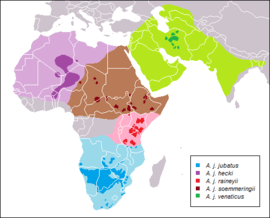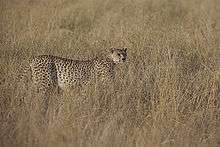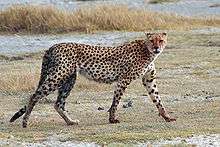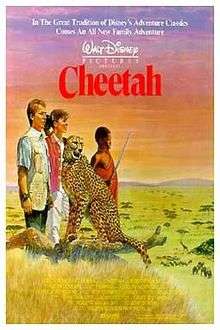Tanzanian cheetah
| Tanzanian cheetah[1] | |
|---|---|
 | |
| A Tanzanian cheetah in Masai Mara, Kenya. | |
| Scientific classification | |
| Kingdom: | Animalia |
| Phylum: | Chordata |
| Class: | Mammalia |
| Order: | Carnivora |
| Family: | Felidae |
| Genus: | Acinonyx |
| Species: | A. jubatus |
| Subspecies: | A. j. raineyii |
| Trinomial name | |
| Acinonyx jubatus raineyii (Heller, 1913) | |
 | |
| A. j. raineyii range (red) | |
| Synonyms | |
|
Acinonyx jubatus fearsoni | |
The Tanzanian cheetah (Acinonyx jubatus raineyii syn. Acinonyx jubatus fearsoni), also commonly known as East African cheetah[3] or Kenyan cheetah, is a subspecies of cheetah native to East Africa. They live in grasslands and savannas of Tanzania, Kenya, Uganda and Somalia. The Tanzanian cheetahs are inhabiting mainly the Serengeti ecosystem, the Maasai Mara and the Tsavo landscape.
These cheetahs are listed as Vulnerable by the IUCN, as it is threatened by habitat loss, predation and cheetah cub mortality rated up to 90% in the Serengeti ecosystem.
In 2007, the total number of cheetahs in East Africa were estimated at 1,960 to 2,572 adults and independent adolescents.[2] Tanzanian cheetahs are the second-largest population after the most numerous South African cheetah. In 2007, there were between 569 and 1,007 cheetahs in Tanzania, between 710 and 793 cheetahs in Kenya, between 40 and 295 cheetahs in Uganda and approximately 200 left in Somalia.[2] Kenya is the main stronghold for Eastern African cheetahs, with the largest population estimated of 800 to 1,200 adults in the country since 2015.[4]
Formerly widespread in East Africa, the East African cheetah have lost high percent of ranges and gone extinct in the eastern Democratic Republic of the Congo, Rwanda and Burundi.[2]
Taxonomy
The Tanzanian cheetah's scientific name was first known as Acinonyx jubatus fearsoni by Smith in 1834 (although it is also spelled "fearoni", "fearonii" or even "fearonis" by Fitzinger in 1869). Until in 1913, the American zoologist Heller proposed the trinomen Acinonyx jubatus raineyii (also spelled Acinonyx jubatus raineyi), which was more preferable for the East African cheetah subspecies. The East African specimen was named in honor of American businessman and hunter Paul J. Rainey.
Meanwhile, two subspecies of East African cheetahs have been proposed. The Eastern East African cheetah Acinonyx jubatus ngorongorensis, also known as Tanzanian cheetah and the Western East African cheetah Acinonyx jubatus velox, also known as Kenyan cheetah,[5] though the latter may be a valid subspecies. However, as of today, all proposed scientific names are considered as synonyms for Acinonyx jubatus raineyii.[6]
Evolutionary history
Not much was known about the Tanzanian cheetah's evolutionary story, although at first, the Eastern and Southern African cheetahs were thought to be identical as the genetic distance between the two subspecies are low.[7] However, in the 1990s, DNA research revealed the Tanzanian cheetahs and their southern cousins are separate subspecies.[8]
It was revealed that back at early Pleistocene, the earliest African cheetah fossils have been found in the lower beds of the Olduvai Gorge site in northern Tanzania, thus making the Tanzanian cheetah the most ancient subspecies.[9]
Physical characteristics

The East African cheetah is the largest subspecies. Cheetahs usually can measure from 110 to 135 cm in head-and-body length and weighs between 20 and 60 kg. The males are usually larger than females. Measurements on wild cheetahs in Tanzania were taken. Tanzanian cheetahs can measure up to between 200 and 220 cm in length and weighs between 40 and 60 kg.[10] Depth of skull and length of mandible are significantly larger in males.[9]
It is the second-palest subspecies after the very pale Northwest African cheetah. The Tanzanian cheetahs have a white-yellowish coat to a tannish coat. Their fur are usually quite shorter and leaner, however some can have a thick coarse fur on the belly. The East African cheetah has many round black spots, some can be found on the chests and neck, except on its white underside. The spots merge toward the end of the tail to form four to fourteen dark rings followed by a white tuft at the tip of the tail. The Tanzanian cheetah's tear marks run from the corner of the eyes to the mouth which reduces the glare of sunlight in its eyes, which is relatively thick. The Tanzanian cheetah also has a slighter build than other African cheetahs.
There had been reports about some Tanzanian cheetah of other color variations, such as melanism and ticked. A black (melanistic) cheetah was sighted in the Trans-Nzoia District of Kenya in 1925. A ticked (spotless) cheetah was shot in Tanzania in 1921, it had only a few very small spots on the neck and back. Another cheetah with this color-morph was photographed in Kenya in 2012.[11]
Habitat and distribution

.jpg)

The Tanzanian cheetahs are native to the eastern region of Africa. They primarily live on scrub forests, grasslands, savannahs, open fields, steppes and arid environments where preys are available, in which are suitable to be the cheetahs' main hunting grounds. A few can also be found at lakeshores and coastal areas, including mountain ranges. The Tanzanian cheetahs of Amboseli National Park also live in arid deserts of Nyiri.
The Tanzanian cheetah's range has the highest density mostly in between northern Tanzania and southern Kenya.[2] The largest populations are mostly found at the Serengeti National Park, the Masai Mara National Reserve, Kora National Park and the Ngorongoro Crater from Tanzania and Kenya,[12] as there were between 569 and 1,007 cheetahs in Tanzania and between 710 and 793 individuals in Kenya. However, in 2015, it is estimated that between 800 and 1,200 adult East African cheetahs reside in Kenya, making the country the main stronghold for the vulnerable species in East Africa.[4]
There are rare sightings of East African cheetahs at the Ngorongoro Conservation Area and in the Katavi National Park from southwest Tanzania. Certain populations of cheetahs in southern Tanzania are unlikely to be the Eastern subspecies, as the southernmost populations found at the southern region of the country are actually South African cheetahs.
The Tanzanian cheetah populations were estimated as around 40 to 295 cheetahs in Uganda as of 2007.[2] Cheetahs are found in Kidepo Valley National Park in northern Uganda. It is estimated that only 20 individuals live in Kidepo since 2014.[13] Some also have recently been spotted in Murchison Falls National Park. The cheetahs, along with lions, are rarely spotted in Murchison Falls.
In 2007, there are 200 Tanzanian cheetahs in Somalia. They may probably persist in the southernmost parts of Ethiopia, sharing borders with the Sudan cheetahs. Though their subpopulations are fragmented in the regions.
Former ranges
The Tanzanian cheetahs have lost most of their historical ranges in the countries they persist and in which are no longer found. The East African cheetah formerly lived in the eastern parts of the Democratic Republic of the Congo (in the North Kivu and South Kivu provinces). The cheetahs previously lived in Virunga National Park. The subspecies might even shared borders with the Sudan cheetah on northeastern regions and the South African cheetah on southeastern regions of the Congo. They are also regionally extinct from Rwanda and Burundi.
Ecology and behavior
Reproduction and life cycle
.jpg)

Male cheetahs are sociable and often live in a group of other males called coalitions. In the Serengeti, it was found that 41% of the adult males were solitary, 40% lived in pairs and 19% lived in trios.[14] Male East African cheetahs are also territorial establish their territories by marking their territories by urinating on trees or logs. They would react aggressively against intruders.
The female Tanzanian cheetah's home ranges can be very large and a territory including several females' ranges is impossible to defend. Instead, males choose the points at which several of the females' home ranges overlap, creating a much smaller space, which can be properly defended against intruders while maximizing the chance of reproduction. Coalitions will try their best to maintain territories to find females with whom they will mate. The size of the territory also depends on the available resources; depending on the habitat, the size of a male's territory can vary greatly from 37 to 160 km2 (14 to 62 sq mi).
Female cheetahs can reproduce at 13 to 16 months of age with an average age of sexual maturity between 21 and 22 months. Cheetah cub births mostly occurs during January to August in East Africa after 90 to 95 days of gestation.[9]
Hunting and diet

Tanzanian cheetahs are diurnal animals (active mainly during the day), whereas the stronger apex predators, such as hyenas, leopards and lions are nocturnal (active mainly at night). Hunting is the major activity throughout the day; peaks are observed during dawn and dusk indicating crepuscular tendencies. Groups rest in grassy clearings after dusk, though males and juveniles often roam around at night.
In Kenya, Tanzanian cheetahs of the Masai Mara hunt after sunset to escape the high temperatures of the day. In the Serengeti, they hunt when the lions and hyenas are inactive. A study in Nairobi National Park showed that the success of Tanzanian cheetah hunt depends on the species, age, sex, and habitat of the prey, and the size of the hunting herd or the efficiency of the hunting individual.[15]
The Tanzanian cheetah usually eats medium-sized or large mammalian herbivores, such as antelopes. It preys on impala, Grant's gazelle, gerenuk, wildebeest, waterbuck, hare and guineafowl. It even feeds on other large mammals, such as plains zebras and ostriches on few occasions. However, its favorite prey is the Thomson's gazelle. The gazelle is found mostly in savannas, grasslands and open fields of the Serengeti ecosystem of Tanzania and the Masai Mara ecosystem of Kenya where the cheetah can chase and catch its prey at full speed.
In Somalia, Tanzanian cheetahs feed on Soemmerring's gazelles. Historically, Speke's gazelles fell prey to the cheetahs, which were formerly the main prey of the Tanzanian cheetahs in semi-deserts and grass steppes of the Horn of Africa. However, it suffers from population decline and habitat degradation.
The East African cheetah hunts at daylight, often during early morning or in the evening. It usually stalks to within a few feet, then chases the animal down at high speed. The cheetah will make its prey trip and fall during the chase, then bites the underside of the throat to suffocate and kill it. It prefers to eat its food quickly to avoid losing it to stronger predators such as lions, leopards and hyenas.
Enemies and competitors
Tanzanian cheetahs are threatened and outranked by larger predators in their area, as they are known to be unable to defend themselves against these predators. In the Serengeti ecosystem, they are highly threatened by lions, as they can kill cheetahs, cause high-rate cheetah cub mortality, also steal their food.
Other predators such as African leopards, East African wild dogs and hyenas also threaten the cheetahs. Spotted and striped hyenas frequently scavenges from the cheetah kills, and the cheetahs would surrender their meals to the incoming hyenas without a fight.
However, coalitions of male adult cheetahs can chase predators away. Even a single cheetah are also known to chase jackals and African golden wolves away from their territory or their food.
Threat


Like all subspecies, the Tanzanian cheetah population is threatened by poaching, habitat loss, fragmentation, predator relationships with lions, leopards, hyenas and painted dogs.
The East African cheetah is also known to have the highest mortality rate of the cheetah cubs. The rate of cheetah cubs' mortality mostly goes up to from 50% to 75% before the age of 3 months,[16] however, the rate of cub mortality varies up to 90% in the Serengeti ecosystem (except in the Maasai Mara ecosystem). It is suspected that the Masai lions are the sources of high mortality of cheetah cubs.[17] In Tanzania's Serengeti ecosystem and in Kenya's Maasai Mara, the East African cheetah mothers would even hide their cubs in tall grass or brush for four or six weeks to keep them safe, as there are high densities of apex predators within the region and the cheetahs native to the Serengeti ecosystem avoid being out of the open.[18]
The Tanzanian cheetahs, mostly from the Serengeti and the Maasai Mara can be affected by infectious disease, although it does not represent a major threat to the free-roaming cheetahs of East Africa.[2]
Conservation

The Tanznian cheetah, including the South African cheetah and Sudan cheetah are listed as Vulnerable in the IUCN Red List of Threatened Animals. The cheetah species is listed on Appendix I of CITES (Convention on International Trade in Endangered Species), Appendix I of CMS (Convention on the Conservation of Migratory Species of Wild Animals) and is protected under national legislation throughout most of its extant and some of its former range.[2]
Despite the numerous reserves and national parks for the East African cheetah, the population still is in decline. There are various conservation projects in order to save the Tanzanian cheetah from extinction, such as the Mara-Meru Cheetah Project, the Serengeti Cheetah Project, Action for Cheetahs in Kenya and the Tanzania Cheetah Conservation Programme.[19]
There are currently no known East African cheetahs in captivity. However, in Whipsnade Zoo features displays that inform visitors about ZSL's cheetah conservation project in Tanzania. Despite the conservation project is involved on East Africa, the captive cheetahs of the zoo are actually Sudan cheetahs from Northeastern Africa.[20]
In popular culture

- The book How It Was with Dooms tells the true story of a family raising an orphaned East African cheetah cub named Duma (the Swahili word for cheetah) in Kenya. The films Cheetah (1989) and Duma (2005) were both loosely based on this book.
- Similarly, Roger Hunt successfully tames an East African cheetah from the Tsavo East National Park in Willard Price's Safari Adventure, after rescuing it from an elephant pit trap. The cheetah soon befriends a German shepherd dog called Zulu.
- André Mercier's Our Friend Yambo (1961) is a curious biography of a cheetah from Kenya adopted by a French couple and brought to live in Paris. It is seen as a French answer to Born Free (1960), whose author, Joy Adamson, produced a cheetah biography of her own, The Spotted Sphinx (1969).
See also
References
| Wikispecies has information related to: Acinonyx jubatus raineyii |
| Wikimedia Commons has media related to Acinonyx jubatus raineyii. |
- ↑ Wozencraft, W.C. (2005). "Order Carnivora". In Wilson, D.E.; Reeder, D.M. Mammal Species of the World: A Taxonomic and Geographic Reference (3rd ed.). Johns Hopkins University Press. p. 533. ISBN 978-0-8018-8221-0. OCLC 62265494.
- 1 2 3 4 5 6 7 8 Durant, S.; Marker, L.; Purchase, N.; Belbachir, F.; Hunter, L.; Packer, C.; Breitenmoser-Wursten, C.; Sogbohossou, E. & Bauer, H. (2015). "Acinonyx jubatus". IUCN Red List of Threatened Species. Version 2014.3. International Union for Conservation of Nature.
- ↑ "Facebook by Wild Catopia East African Cheetah (Acinonyx jubatus fearsoni/raineyii)". Retrieved 3 December 2014.
- 1 2 Rupi Mangat (2 October 2015). "World cheetah population endangered". TheEastAfrican.co.ke. Retrieved 18 October 2015.
- ↑ Murray Wrobel (2006). Elsevier's Dictionary of Mammals. Elsevier. Retrieved 9 January 2016.
- ↑ T. M. Caro (1994). Cheetahs of the Serengeti Plains: Group Living in an Asocial Species. University of Chicago Press. Retrieved 9 January 2016.
- ↑ O’Brien S. J. 1987. East African Cheetahs: Evidence for Two Population Bottlenecks? Proceedings of the National Academy of Sciences of the United States of America. 84:508-11.
- ↑ "Iran's endangered cheetahs are a unique subspecies.". BBC - Earth News. 24 January 2011. Retrieved 3 December 2014.
- 1 2 3 Krausman, P. R.; Morales, S. M. (2005). "Acinonyx jubatus" (PDF). Mammalian Species. 771: 1–6. doi:10.1644/1545-1410(2005)771[0001:aj]2.0.co;2.
- ↑ Mary Fitzpatrick (2010). Tanzania. Lonely Planet. Retrieved 17 January 2016.
- ↑ "The lesser-spotted cheetah: Rare big cat without traditional markings sighted in wild for first time in nearly 100 years". Daily Mail. London. 2012-04-25. Retrieved 2013-03-06.
- ↑ "Acinonyx jubatus". catsg.org. Retrieved 3 December 2014.
- ↑ "Cheetah's Return to Kidepo Valley National Park". Uganda Adventure Safaris. 4 February 2014. Retrieved 29 February 2016.
- ↑ Richard Estes, foreword by Edward Osborne Wilson (1991) The Behavior Guide to African Mammals. University of California Press. Page 371.
- ↑ Eaton, R.L. (1970). "Hunting behavior of the cheetah". The Journal of Wildlife Management. 34 (1): 56–67. doi:10.2307/3799492. JSTOR 3799492.
- ↑ "Cheetah Facts". Tigerhomes.org. Retrieved 17 January 2016.
- ↑ , Cheetah cub survival revisited: a re-evaluation of the role of predation, especially by lions, and implications for conservation
- ↑ "Cheetah". National Geographic. Retrieved 1 November 2015.
- ↑ The Tanzania Cheetah Conservation Programme
- ↑ Florian Krepcik; Monika Fiby (4 June 2011), Zoological Society of London (ZSL) Whipsnade Zoo Cheetah Rock, ZooLex.org, retrieved 8 February 2015
